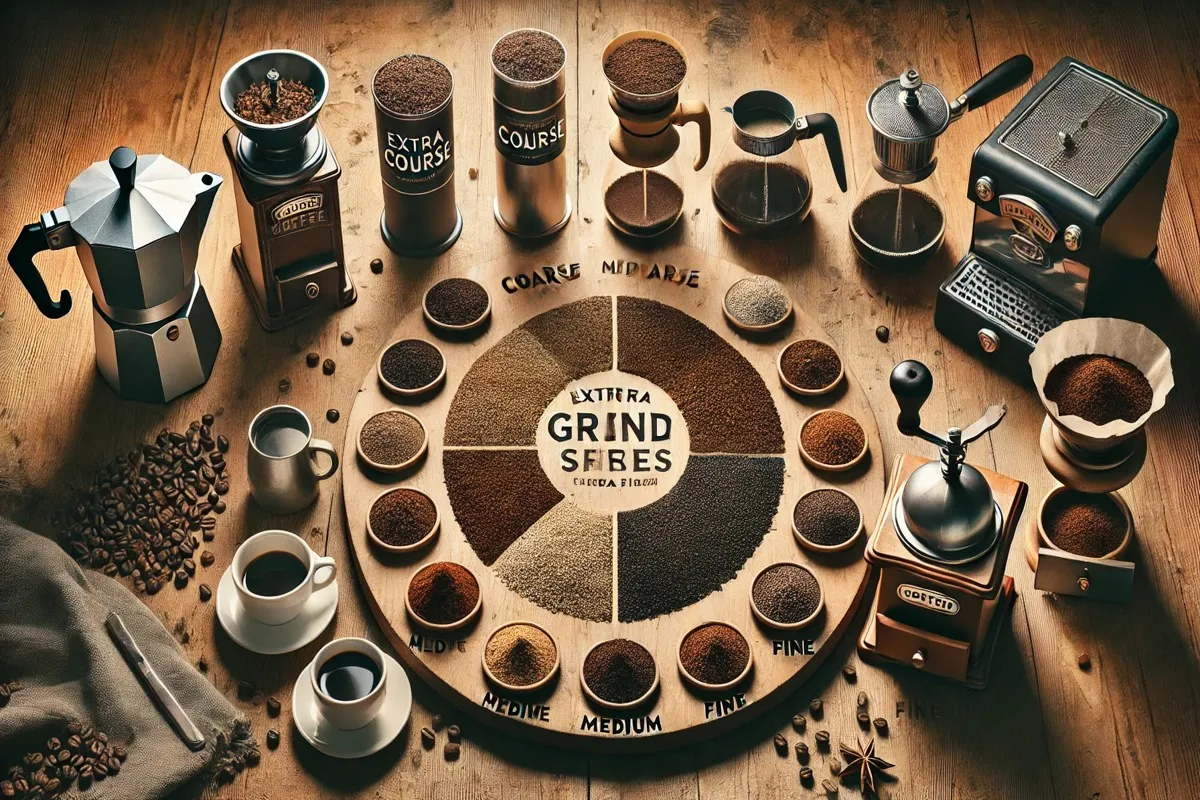📚 Table of Contents
When it comes to making great coffee, grind size is one of the most important things to get right. It’s not just about grinding beans and brewing;
The size of your coffee grounds affects how water interacts with them, which changes the flavor, strength, and overall quality of your coffee.
Different coffee brewing methods, like a French press, espresso machine, or cold brew, need different grind sizes to taste their best. Using the wrong size can make your coffee taste too bitter or too weak.
 |
| Different grind size of coffee beans blend else Flavor |
In this guide, we’ll break it all down for you, from the basics of grind size to which grind works best for each brewing method.
By the end, you’ll have a clear understanding of how to grind your beans perfectly for your favorite brew.
What Is Coffee Grind Size and Why Does It Matter?
Grind size refers to how big or small the coffee particles are after you grind your beans. This matters because it affects extraction, the process where water pulls out the flavors from the coffee grounds.
If your grind is:
Too coarse (big pieces): Water flows through too quickly, so you don’t get enough flavor, leaving your coffee weak and sour.
Too fine (tiny pieces): Water takes too long to pass through, pulling out too much flavor and making your coffee bitter.
Finding the right grind size for your brewing method helps you get that perfect cup of coffee—balanced, flavorful, and just how you like it.
Coffee Grind Size Chart
Here’s a simple chart to match grind size with brewing methods:
Let’s Talk About Each Grind Size
1. Extra-Coarse Grind
What It Looks Like: Large, chunky pieces, similar to sea salt or crushed peppercorns.
Best For: Cold brew coffee.
Why It Works: Cold brew takes a long time (12–24 hours) to steep in cold water. The large grounds allow a slow, steady extraction, preventing over-extraction and bitterness.
2. Coarse Grind
What It Looks Like: Slightly smaller than extra-coarse but still chunky, like kosher salt.
Best For: French press and percolators.
Why It Works: The French press requires immersion brewing, where coffee grounds sit in hot water for 4–5 minutes. Coarse grounds ensure the water extracts the right amount of flavor without overdoing it.
3. Medium-Coarse Grind
What It Looks Like: Gritty, like rough sand.
Best For: Chemex and drip coffee makers with cone-shaped filters.
Why It Works: Medium-coarse grounds strike a balance for methods that need water to pass through slowly but not too slowly. It avoids clogging filters while ensuring proper flavor extraction.
4. Medium Grind
What It Looks Like: Like regular table salt.
Best For: Pour-over coffee and Aero Press (with short brew times).
Why It Works: Medium grounds allow water to flow through evenly, making it ideal for pour-over brews where control over water flow is key.
5. Fine Grind
What It Looks Like: Smooth and slightly powdery, similar to sugar or powdered sugar.
Best For: Espresso machines and Mocha pots.
Why It Works: Espresso requires high pressure and short brewing times. Fine grounds provide enough surface area for quick, even extraction, resulting in a strong, rich coffee.
6. Extra-Fine Grind
What It Looks Like: Almost flour-like, very powdery.
Best For: Turkish coffee.
Why It Works: Turkish coffee is brewed without filtering the grounds. The extra-fine grind dissolves almost completely, creating a thick, intensely flavored brew.
Why Grind Size Is So Important
The grind size you choose isn’t just a small detail—it’s a big deal when it comes to how your coffee tastes. Here’s why:
1. Extraction Time
The size of your coffee grounds controls how long the water takes to pass through them. For example:
Coarse grinds take longer for water to extract flavor because they have less surface area.
Fine grinds extract flavor quickly because the small particles have more surface area.
Matching the grind size with the brewing time is key. Short brewing methods (like espresso) need fine grinds, while long methods (like cold brew) need coarse grinds.
2. Flavor Balance
The right grind size helps avoid two common problems:
Under-extraction: This happens when the grind is too coarse or the brewing time is too short, leaving your coffee sour and weak.
Over-extraction: This happens when the grind is too fine or the brewing time is too long, making your coffee taste bitter and harsh.
Finding the sweet spot gives you a balanced, delicious cup every time.
Tips for Getting the Perfect Grind
Use a Burr Grinder
Burr grinders crush coffee beans evenly, unlike blade grinders, which chop beans into uneven pieces. Even grounds lead to consistent flavor.Adjust Based on Taste
If your coffee tastes sour, try a finer grind. If it tastes bitter, go coarser.Grind Fresh
Coffee tastes best when it’s freshly ground. Grind just before brewing to capture the best flavors.Experiment with Your Brewer
Each coffee maker is slightly different. Test different grind sizes and brewing times to find your perfect combination.
In conclusion, Grind size is the foundation of a great cup of coffee. Whether you’re brewing cold brew, espresso, or French press, choosing the right grind size ensures you get the best flavor from your beans.
Take the time to experiment and adjust your grind size to match your brewing method. With practice, you’ll discover how this simple adjustment can make a huge difference in your daily cup of coffee.
So, grab your favorite beans, set up your grinder, and start exploring.
its good to helping me to improve my flavor knowledge. i want to learn more about roasting
ReplyDelete